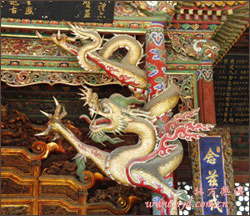
Shenyang's old imperial palace, one of two in the nation, is getting spruced up for next month's United Nations Educational, Scientific and Cultural Organization (UNESCO) inspection.
The Shenyang imperial palace, the only integrated royal architectural complex in China apart from the Forbidden City in Beijing, is applying for listing as a World Heritage Site.
"Its strong characteristics of the Manchu nationality are unique in China and the world. I am confident about the application," said Zhi Yunting, director of the Shenyang Imperial Palace Museum.
The ongoing renovation work involves two parts - the restoration of the inner buildings and the cleaning of the surrounding area, said Zhi.
"We will remove all the ill-suited modern items such as the concrete roof and try to restore it to its original appearance," said Zhi.
To protect the original decorations, the museum staff are using a paste made of flour and some special chemicals to clean the coloured mural of Phoenix Tower, one of the tallest buildings in the palace compound.
Archaeologists have also tried to find and restore all of the decayed original buildings such as the concubine's tomb and the imperial toilet.
The Shenyang Imperial Palace was built by Nurhach (1559-1626) and his heir Huangtaiji (1592-1643) (of the Manchu nationality) in 1625.
Shenyang was later used as an "auxiliary capital" after the Qing Dynasty (1644-1911) moved its capital to Beijing in 1644.
(China Daily July 29, 2003)
|

